Skeletal Muscles - Anatomy and Physiology
Download as PPT, PDF0 likes62 views
Anatomy and Physiology
1 of 24
Download to read offline
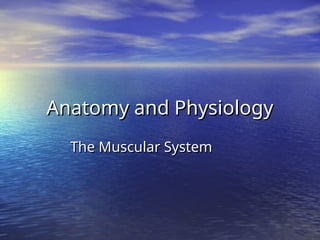

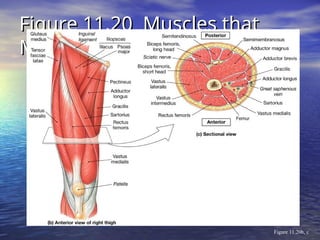
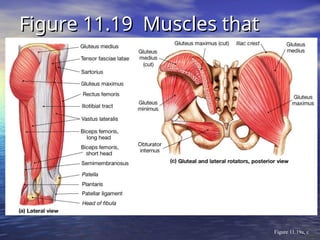
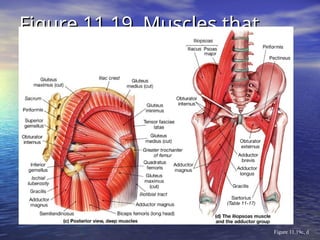
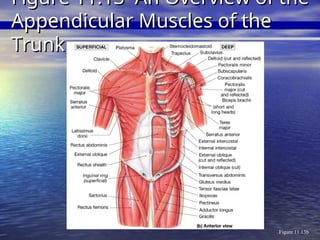
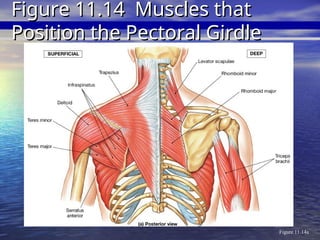
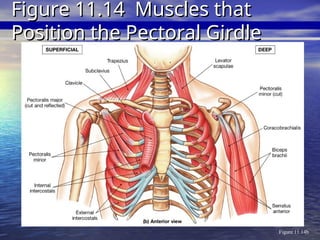
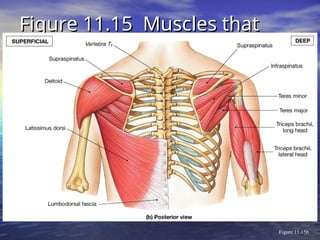
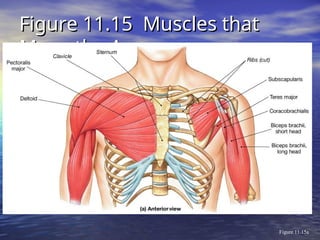
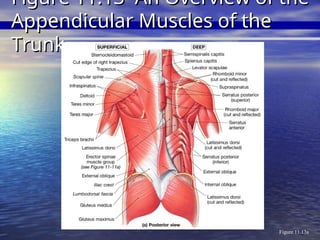

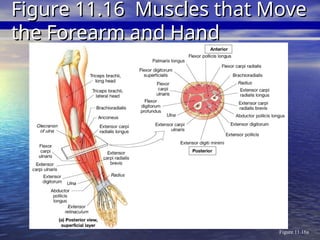
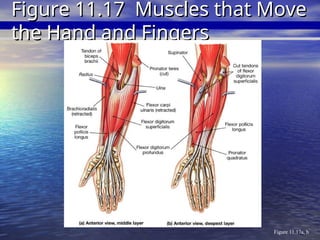
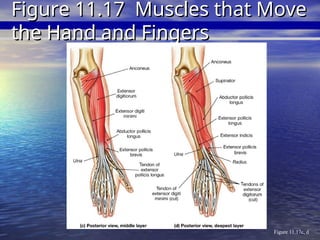

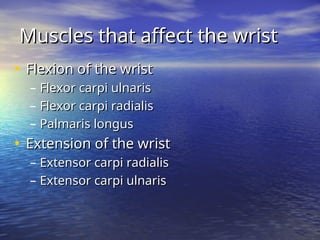
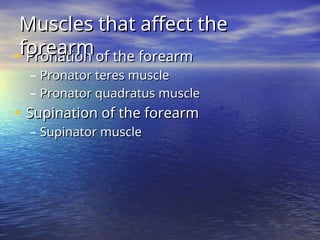
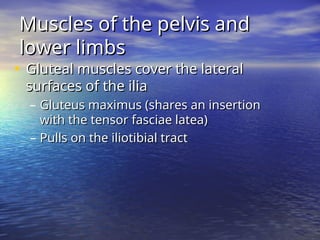
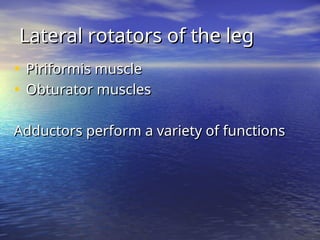
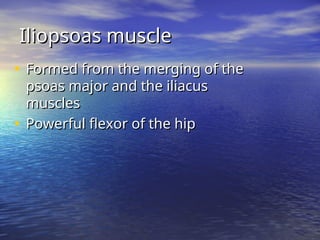
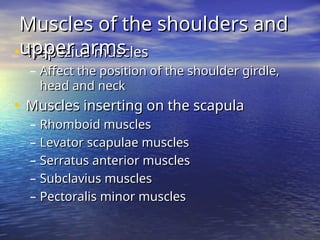
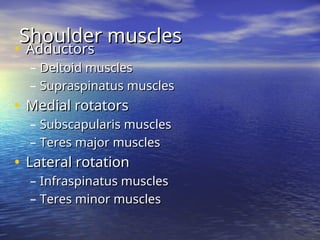

Ad
Recommended
Muscles
MusclesEman Abdallah
Ěý
- The document describes the major skeletal muscles of the human body, including their names, actions, and innervation patterns. It discusses muscles grouped by body region, including the scalp, face, thorax, abdomen, pelvis, upper and lower limbs. Key muscle actions are flexion, extension, abduction, adduction, and rotation. Muscles work in opposing pairs or groups to enable movement.Pelvic, hip knee, Bones, Joints and Muscles
Pelvic, hip knee, Bones, Joints and MusclesNAO, Medical University of Shahid Beheshti
Ěý
The document provides information on the anatomy and function of the pelvis, hip, knee, ankle, and foot. It describes the bones, joints, ligaments, and muscles of the pelvic girdle and lower extremities. Key points covered include the bones and joints of the pelvis, hip muscles and their actions, knee ligaments and movements, ankle and foot arches, and common injuries or conditions that affect the lower extremities.Ch 10 and 11 part 5
Ch 10 and 11 part 5schwartzcm
Ěý
The document describes the muscles of the pelvic girdle and lower limbs. It divides the muscles into three groups - muscles that move the thigh, muscles that move the leg, and muscles that move the foot and toes. For the thigh muscles, it describes the gluteal group, lateral rotator group, adductor group, and iliopsoas group. For the leg muscles, it outlines the quadriceps femoris (extensors of the knee), hamstrings (flexors of the knee), and other flexors like the sartorius and popliteus. For the foot and toe muscles, it identifies the extrinsic muscles that originate proximally and intrinsic muscles that originate on the foot.LECTURE1 -Anatomy_of_Musculoskeletal_System.ppt
LECTURE1 -Anatomy_of_Musculoskeletal_System.pptAhmedFouad252659
Ěý
I do not have enough context from the document to summarize the key points of how specific muscles enable walking, running, jumping or their mechanisms. The document provides a detailed anatomical overview of the musculoskeletal system but does not explain those specific activities.Arm+shoulder anatomy***
Arm+shoulder anatomy***Rachel Perry
Ěý
The document discusses the anatomy of the arm and shoulder. It begins by identifying the bones of the upper arm and shoulder girdle. It then describes the rotator cuff muscles and their role in stabilizing the shoulder joint and allowing shoulder rotation. It discusses common shoulder issues like impingement and rotator cuff tears that can result from weakness or overuse of these muscles. Finally, it reviews some of the major muscles of the upper body and stretches and exercises to strengthen these muscles.Ch 10 and 11 part 2
Ch 10 and 11 part 2schwartzcm
Ěý
The document describes the muscles that move the arm, forearm, hand, and fingers. It discusses both extrinsic muscles that originate elsewhere and move the regions, as well as smaller intrinsic muscles within the regions. The major muscles discussed include the biceps brachii, triceps brachii, flexor digitorum superficialis, extensor digitorum, and several small muscles responsible for fine motor control of the fingers and thumb. Diagrams are included highlighting the origin, insertion, and action of key muscles.Lower Extremities.pptx
Lower Extremities.pptxParamanand Gopie
Ěý
The lower limb muscles are larger and stronger than the upper limb muscles. They function in stability, locomotion, and posture. The lower limb muscles can be divided into muscles of the hip, thigh, leg, and foot. The major muscle groups that move the thigh are the gluteals and adductors, which originate on the pelvic girdle and insert on the femur. The muscles of the leg are divided into anterior, lateral, and posterior compartments by deep fascia. The intrinsic muscles of the foot originate and insert within the foot and are responsible for toe movements and supporting the arches.CORE Essentials
CORE EssentialsECHO Interactive Consulting
Ěý
The document provides a detailed overview of core stability, including the muscles involved, their origins, insertions, and actions. It covers various muscle groups contributing to core strength, such as the abdominal muscles, erector spinae, and hip flexors, emphasizing their roles in stabilizing the body during movement and sports activities. Additionally, it briefly touches on specific muscles like the rectus abdominis, transversus abdominis, and several hip adductors.Appendicular muscles
Appendicular musclesPave Medicine
Ěý
This document provides information on the appendicular muscles of the human body. It discusses how these muscles are organized into groups based on their location and the parts of the skeleton they move. The major muscle groups covered include: muscles that move the pectoral and pelvic girdles; muscles that move the arms, forearms, wrists and hands; muscles that move the thighs, hips and legs; and intrinsic hand muscles. For each group, the document identifies specific muscles and their functions, such as flexion, extension, abduction and rotation.Muscles-of-the Upper-Limb By Rohit steeva .pptx
Muscles-of-the Upper-Limb By Rohit steeva .pptxarunmanikandan6
Ěý
The document provides a comprehensive overview of the muscles of the upper limb, detailing the key muscle groups in the shoulder, upper arm, forearm, and hand, along with their functions and clinical significance. It highlights the roles of major muscles such as the deltoid, biceps brachii, and intrinsic hand muscles in movement and stabilization, while also discussing common clinical issues like rotator cuff tears and carpal tunnel syndrome. The content serves as an educational resource on the anatomy and function of upper limb muscles.Arjun Presentation about lower body .pptx
Arjun Presentation about lower body .pptxLocalAcc
Ěý
The document details the functions and anatomical structure of the leg muscles, dividing them into upper and lower legs, alongside the gluteal region. It highlights specific muscles, their functions, and exercises designed to strengthen these muscle groups while also discussing the importance of calf muscles in promoting cardiovascular health. Additionally, it suggests implementing short breaks to activate these muscles to prevent negative health effects associated with prolonged sitting.12 Appendicular Muscles
12 Appendicular Musclesguest334add
Ěý
The document discusses the muscles that control movements of the upper and lower limbs. It begins by covering muscles of the pectoral girdle and upper arm, including the serratus anterior muscle which protracts and depresses the scapula. It then discusses muscles of the pelvic girdle and lower limb, including the quadriceps femoris muscles which extend the knee and hamstring muscles which flex the knee.Muscular system
Muscular systemcoloncin
Ěý
The document provides an overview of the three main types of muscle tissue - skeletal, cardiac, and smooth muscle - and their characteristics. It then discusses in detail the various muscles in the human body, describing their locations, functions, names and how muscles produce movement. Key muscle groups like those in the face, neck, shoulder, arm and abdominal areas are outlined.Ch 10 and 11 part 1
Ch 10 and 11 part 1schwartzcm
Ěý
The document discusses the appendicular musculature, which includes muscles of the pectoral girdle and upper limbs, and muscles of the pelvic girdle and lower limbs. It describes several key muscle groups that position the pectoral girdle including the trapezius, levator scapulae, rhomboid major and minor, serratus anterior, subclavius. It also discusses muscles that move the arm including the deltoid, pectoralis major, coracobrachialis, biceps brachii, teres major, subscapularis. The action lines of muscles are described as well as how they determine the muscle's function at theCh11lecturepresentation 140913123842-phpapp02
Ch11lecturepresentation 140913123842-phpapp02Cleophas Rwemera
Ěý
The document discusses the appendicular musculature, which includes muscles of the pectoral girdle and upper limbs, and muscles of the pelvic girdle and lower limbs. It provides diagrams and descriptions of these muscle groups, including their actions, innervations, and roles in stabilizing joints and moving limbs. Key muscle groups covered are rotator cuff muscles, muscles that position and move the arm, forearm, hand, thigh, leg, and foot.Chapter 11
Chapter 11dquevedo1
Ěý
This document provides information about the muscular system, including how muscles are named based on their location, size, fiber direction, attachments and actions. It discusses the three types of levers in the body and describes coordination between agonist, antagonist and synergist muscles. Finally, it summarizes the origins, insertions and actions of many major skeletal muscles in the head, neck, trunk and extremities.PEShare.co.uk Shared Resource
PEShare.co.uk Shared Resourcepeshare.co.uk
Ěý
This document provides an overview of movement analysis for sports studies. It discusses the planes and axes of movement, types of joints and muscle contractions, and the roles of specific muscles in actions like running, kicking, jumping, and racket sports. It also covers levers and their mechanical advantages. Key points covered include the identification of agonists and antagonists, analysis of joint actions, and understanding movement in the sagittal, frontal and transverse planes.Class 6 Ap1 Muscles
Class 6 Ap1 MusclesCCMT
Ěý
This document provides information on muscles of the pelvis and thigh, including their origins, insertions, and actions. It describes muscles like the gluteus maximus, psoas major, rectus femoris, and biceps femoris. It also provides instructions for palpating several of these muscles, such as feeling for the contraction of the psoas major when flexing the thigh.Anatomy of the upper limb muscles. .ppt
Anatomy of the upper limb muscles. .ppteretancharles2022
Ěý
The document provides an overview of the muscles associated with the upper limb, specifically those responsible for movements of the pectoral girdle, elbow joint, forearm, wrist, hand, and fingers. It categorizes muscles into superficial and deep groups and details their origins, insertions, and actions. This summary highlights the functional anatomy of the muscles, emphasizing their roles in stabilizing and moving the shoulder, arm, and hand.Arm muscles ppt
Arm muscles pptnihattt
Ěý
The document discusses the muscles that move the forearm and hand. It describes 13 muscles that flex and extend the elbow and wrist, including the biceps brachii, triceps brachii, brachialis, and various flexor and extensor carpi muscles. It also mentions muscles like the pronator teres and supinator that rotate the radius bone of the forearm. Finally, it notes there are additional intrinsic hand muscles that help move the fingers.Upper limb muscles
Upper limb musclesJay Patel
Ěý
The document summarizes several muscles of the upper limb. It describes the origin, insertion, innervation, and action of key muscles that act on the shoulder, arm, forearm, wrist and hand. Some of the major muscles discussed include:
- Pectoralis major, which flexes, adducts and rotates the arm medially at the shoulder.
- Latissimus dorsi, which extends, adducts and rotates the humerus medially, retracting the shoulder.
- Deltoid, which flexes and medially rotates the arm, abducts the arm, and extends and laterally rotates the arm.
- Triceps bra4. Muscles.docx
4. Muscles.docxAshutoshPandey966553
Ěý
There are approximately 650 muscles in the human body that are classified into three types: skeletal, smooth, and cardiac. Muscles are made of proteins and have properties like irritability, contractibility, extensibility, and elasticity. The major muscles around joints like the shoulder, elbow, hip, knee, and trunk are described. These include muscles like the deltoid, biceps, triceps, gluteals, quadriceps, hamstrings, and abdominal muscles. Their actions in fundamental movements like flexion, extension, abduction, adduction, and rotation are explained.11 [chapter 11 the muscular system][11e]
11 [chapter 11 the muscular system][11e]Sompoch Thanachaikan
Ěý
The document provides an outline for a chapter on the muscular system. It discusses how skeletal muscles produce movement using levers and muscle coordination. It describes the naming of muscles and then reviews the principal muscles in the head, neck, trunk, and upper limb, including their origins, insertions, actions and innervation. Key points covered include the actions of muscles in facial expression, eye movement, jaw movement, tongue movement, breathing, and limb movement.Afaa pft anatomy and kinesiology
Afaa pft anatomy and kinesiologyRwilsoncpt
Ěý
1. The document describes various anatomical terms including anatomical position, planes of motion, and general joint actions like flexion, extension, abduction, and rotation.
2. It then discusses specific joint actions at the shoulder, elbow, spine, pelvis, knee, ankle, and muscle groups that act on these joints.
3. Key muscle groups are described along with their primary actions, such as the quadriceps extending the knee and the biceps flexing the elbow. Opposing muscle groups around each joint are also listed.Awesome_Abs_SDAHPERD
Awesome_Abs_SDAHPERDGale Wiedow
Ěý
This document provides an overview of core training, emphasizing the importance of core muscles, safety, and instructional cues for various abdominal exercises. It details different core muscles such as the transverse abdominis, obliques, and rectus abdominis, along with their functions and benefits. Additionally, it outlines a series of exercise variations and cues for performing standing, prone, yoga, and supine exercises effectively.Class 1 Ap1 Muscles
Class 1 Ap1 MusclesCCMT
Ěý
This document provides information about muscles of the scapula and arm region, including descriptions of key muscles and guidance on palpating them. It discusses muscles like the supraspinatus, infraspinatus, teres minor, subscapularis, teres major, deltoid, coracobrachialis, biceps brachii, brachialis, and triceps brachii. Instructions are given on palpating the attachments and actions of these muscles through range of motion exercises and muscle contraction against resistance.Plank with Forward Arm Lift
Plank with Forward Arm LiftSaoriHanaki
Ěý
1. The plank with forward arm lift exercise targets the core muscles of the abs and obliques through isometric contractions in the plank position and involves lifting one arm at a time from a straight position to parallel with the body while maintaining proper form.
2. Proper form involves keeping the elbows under the shoulders, shoulders at 90 degrees, and hips, knees, neck, ears and heels aligned while looking at the ground and keeping the core tight without rotating the hips.
3. Common form errors include arching the back by not engaging the core, lowering the hips, looking up or forward instead of down, and over-rotating the trunk, all of which can lead to injury or make theClass One Ap1 Muscles
Class One Ap1 MusclesCCMT
Ěý
This document provides information about muscles of the scapula and arm region including:
- Descriptions of the supraspinatus, infraspinatus, teres minor, and subscapularis muscles and their attachments, actions, and involvement in shoulder rotation.
- Instructions for palpating the teres major muscle and feeling its contraction with arm movements.
- Guidance for properly palpating the rotator cuff muscles and feeling their contractions during specific arm movements against resistance.Hermann Maier’s Unthinkable Comeback Triumph at the 1998 Nagano Winter Olympi...
Hermann Maier’s Unthinkable Comeback Triumph at the 1998 Nagano Winter Olympi...Winter Olympic Tickets
Ěý
The upcoming Winter Olympic, dubbed the Milano Cortina 2026 Games, will last 17 days in and around the stunning Italian Alps.
https://www.eticketing.co/sports-tickets/winter-olympic-tickets/olympic-alpine-skiing-tickets/
#OlympicAlpineSkiingTickets,#WinterOlympicTickets,#WinterOlympic2026,#ItalyWinterOlympicTickets,#WinterOlympicTickets,#WinterOlympicMilanoCortina2026Tickets,#WinterOlympicGamesTickets,#MilanoCortina2026Tickets,#OlympicOpeningCeremonyTicketsMore Related Content
Similar to Skeletal Muscles - Anatomy and Physiology (20)
Appendicular muscles
Appendicular musclesPave Medicine
Ěý
This document provides information on the appendicular muscles of the human body. It discusses how these muscles are organized into groups based on their location and the parts of the skeleton they move. The major muscle groups covered include: muscles that move the pectoral and pelvic girdles; muscles that move the arms, forearms, wrists and hands; muscles that move the thighs, hips and legs; and intrinsic hand muscles. For each group, the document identifies specific muscles and their functions, such as flexion, extension, abduction and rotation.Muscles-of-the Upper-Limb By Rohit steeva .pptx
Muscles-of-the Upper-Limb By Rohit steeva .pptxarunmanikandan6
Ěý
The document provides a comprehensive overview of the muscles of the upper limb, detailing the key muscle groups in the shoulder, upper arm, forearm, and hand, along with their functions and clinical significance. It highlights the roles of major muscles such as the deltoid, biceps brachii, and intrinsic hand muscles in movement and stabilization, while also discussing common clinical issues like rotator cuff tears and carpal tunnel syndrome. The content serves as an educational resource on the anatomy and function of upper limb muscles.Arjun Presentation about lower body .pptx
Arjun Presentation about lower body .pptxLocalAcc
Ěý
The document details the functions and anatomical structure of the leg muscles, dividing them into upper and lower legs, alongside the gluteal region. It highlights specific muscles, their functions, and exercises designed to strengthen these muscle groups while also discussing the importance of calf muscles in promoting cardiovascular health. Additionally, it suggests implementing short breaks to activate these muscles to prevent negative health effects associated with prolonged sitting.12 Appendicular Muscles
12 Appendicular Musclesguest334add
Ěý
The document discusses the muscles that control movements of the upper and lower limbs. It begins by covering muscles of the pectoral girdle and upper arm, including the serratus anterior muscle which protracts and depresses the scapula. It then discusses muscles of the pelvic girdle and lower limb, including the quadriceps femoris muscles which extend the knee and hamstring muscles which flex the knee.Muscular system
Muscular systemcoloncin
Ěý
The document provides an overview of the three main types of muscle tissue - skeletal, cardiac, and smooth muscle - and their characteristics. It then discusses in detail the various muscles in the human body, describing their locations, functions, names and how muscles produce movement. Key muscle groups like those in the face, neck, shoulder, arm and abdominal areas are outlined.Ch 10 and 11 part 1
Ch 10 and 11 part 1schwartzcm
Ěý
The document discusses the appendicular musculature, which includes muscles of the pectoral girdle and upper limbs, and muscles of the pelvic girdle and lower limbs. It describes several key muscle groups that position the pectoral girdle including the trapezius, levator scapulae, rhomboid major and minor, serratus anterior, subclavius. It also discusses muscles that move the arm including the deltoid, pectoralis major, coracobrachialis, biceps brachii, teres major, subscapularis. The action lines of muscles are described as well as how they determine the muscle's function at theCh11lecturepresentation 140913123842-phpapp02
Ch11lecturepresentation 140913123842-phpapp02Cleophas Rwemera
Ěý
The document discusses the appendicular musculature, which includes muscles of the pectoral girdle and upper limbs, and muscles of the pelvic girdle and lower limbs. It provides diagrams and descriptions of these muscle groups, including their actions, innervations, and roles in stabilizing joints and moving limbs. Key muscle groups covered are rotator cuff muscles, muscles that position and move the arm, forearm, hand, thigh, leg, and foot.Chapter 11
Chapter 11dquevedo1
Ěý
This document provides information about the muscular system, including how muscles are named based on their location, size, fiber direction, attachments and actions. It discusses the three types of levers in the body and describes coordination between agonist, antagonist and synergist muscles. Finally, it summarizes the origins, insertions and actions of many major skeletal muscles in the head, neck, trunk and extremities.PEShare.co.uk Shared Resource
PEShare.co.uk Shared Resourcepeshare.co.uk
Ěý
This document provides an overview of movement analysis for sports studies. It discusses the planes and axes of movement, types of joints and muscle contractions, and the roles of specific muscles in actions like running, kicking, jumping, and racket sports. It also covers levers and their mechanical advantages. Key points covered include the identification of agonists and antagonists, analysis of joint actions, and understanding movement in the sagittal, frontal and transverse planes.Class 6 Ap1 Muscles
Class 6 Ap1 MusclesCCMT
Ěý
This document provides information on muscles of the pelvis and thigh, including their origins, insertions, and actions. It describes muscles like the gluteus maximus, psoas major, rectus femoris, and biceps femoris. It also provides instructions for palpating several of these muscles, such as feeling for the contraction of the psoas major when flexing the thigh.Anatomy of the upper limb muscles. .ppt
Anatomy of the upper limb muscles. .ppteretancharles2022
Ěý
The document provides an overview of the muscles associated with the upper limb, specifically those responsible for movements of the pectoral girdle, elbow joint, forearm, wrist, hand, and fingers. It categorizes muscles into superficial and deep groups and details their origins, insertions, and actions. This summary highlights the functional anatomy of the muscles, emphasizing their roles in stabilizing and moving the shoulder, arm, and hand.Arm muscles ppt
Arm muscles pptnihattt
Ěý
The document discusses the muscles that move the forearm and hand. It describes 13 muscles that flex and extend the elbow and wrist, including the biceps brachii, triceps brachii, brachialis, and various flexor and extensor carpi muscles. It also mentions muscles like the pronator teres and supinator that rotate the radius bone of the forearm. Finally, it notes there are additional intrinsic hand muscles that help move the fingers.Upper limb muscles
Upper limb musclesJay Patel
Ěý
The document summarizes several muscles of the upper limb. It describes the origin, insertion, innervation, and action of key muscles that act on the shoulder, arm, forearm, wrist and hand. Some of the major muscles discussed include:
- Pectoralis major, which flexes, adducts and rotates the arm medially at the shoulder.
- Latissimus dorsi, which extends, adducts and rotates the humerus medially, retracting the shoulder.
- Deltoid, which flexes and medially rotates the arm, abducts the arm, and extends and laterally rotates the arm.
- Triceps bra4. Muscles.docx
4. Muscles.docxAshutoshPandey966553
Ěý
There are approximately 650 muscles in the human body that are classified into three types: skeletal, smooth, and cardiac. Muscles are made of proteins and have properties like irritability, contractibility, extensibility, and elasticity. The major muscles around joints like the shoulder, elbow, hip, knee, and trunk are described. These include muscles like the deltoid, biceps, triceps, gluteals, quadriceps, hamstrings, and abdominal muscles. Their actions in fundamental movements like flexion, extension, abduction, adduction, and rotation are explained.11 [chapter 11 the muscular system][11e]
11 [chapter 11 the muscular system][11e]Sompoch Thanachaikan
Ěý
The document provides an outline for a chapter on the muscular system. It discusses how skeletal muscles produce movement using levers and muscle coordination. It describes the naming of muscles and then reviews the principal muscles in the head, neck, trunk, and upper limb, including their origins, insertions, actions and innervation. Key points covered include the actions of muscles in facial expression, eye movement, jaw movement, tongue movement, breathing, and limb movement.Afaa pft anatomy and kinesiology
Afaa pft anatomy and kinesiologyRwilsoncpt
Ěý
1. The document describes various anatomical terms including anatomical position, planes of motion, and general joint actions like flexion, extension, abduction, and rotation.
2. It then discusses specific joint actions at the shoulder, elbow, spine, pelvis, knee, ankle, and muscle groups that act on these joints.
3. Key muscle groups are described along with their primary actions, such as the quadriceps extending the knee and the biceps flexing the elbow. Opposing muscle groups around each joint are also listed.Awesome_Abs_SDAHPERD
Awesome_Abs_SDAHPERDGale Wiedow
Ěý
This document provides an overview of core training, emphasizing the importance of core muscles, safety, and instructional cues for various abdominal exercises. It details different core muscles such as the transverse abdominis, obliques, and rectus abdominis, along with their functions and benefits. Additionally, it outlines a series of exercise variations and cues for performing standing, prone, yoga, and supine exercises effectively.Class 1 Ap1 Muscles
Class 1 Ap1 MusclesCCMT
Ěý
This document provides information about muscles of the scapula and arm region, including descriptions of key muscles and guidance on palpating them. It discusses muscles like the supraspinatus, infraspinatus, teres minor, subscapularis, teres major, deltoid, coracobrachialis, biceps brachii, brachialis, and triceps brachii. Instructions are given on palpating the attachments and actions of these muscles through range of motion exercises and muscle contraction against resistance.Plank with Forward Arm Lift
Plank with Forward Arm LiftSaoriHanaki
Ěý
1. The plank with forward arm lift exercise targets the core muscles of the abs and obliques through isometric contractions in the plank position and involves lifting one arm at a time from a straight position to parallel with the body while maintaining proper form.
2. Proper form involves keeping the elbows under the shoulders, shoulders at 90 degrees, and hips, knees, neck, ears and heels aligned while looking at the ground and keeping the core tight without rotating the hips.
3. Common form errors include arching the back by not engaging the core, lowering the hips, looking up or forward instead of down, and over-rotating the trunk, all of which can lead to injury or make theClass One Ap1 Muscles
Class One Ap1 MusclesCCMT
Ěý
This document provides information about muscles of the scapula and arm region including:
- Descriptions of the supraspinatus, infraspinatus, teres minor, and subscapularis muscles and their attachments, actions, and involvement in shoulder rotation.
- Instructions for palpating the teres major muscle and feeling its contraction with arm movements.
- Guidance for properly palpating the rotator cuff muscles and feeling their contractions during specific arm movements against resistance.Recently uploaded (8)
Hermann Maier’s Unthinkable Comeback Triumph at the 1998 Nagano Winter Olympi...
Hermann Maier’s Unthinkable Comeback Triumph at the 1998 Nagano Winter Olympi...Winter Olympic Tickets
Ěý
The upcoming Winter Olympic, dubbed the Milano Cortina 2026 Games, will last 17 days in and around the stunning Italian Alps.
https://www.eticketing.co/sports-tickets/winter-olympic-tickets/olympic-alpine-skiing-tickets/
#OlympicAlpineSkiingTickets,#WinterOlympicTickets,#WinterOlympic2026,#ItalyWinterOlympicTickets,#WinterOlympicTickets,#WinterOlympicMilanoCortina2026Tickets,#WinterOlympicGamesTickets,#MilanoCortina2026Tickets,#OlympicOpeningCeremonyTicketsItaly FIFA World Cup Italy Poised to Clinch FIFA 2026 Playoff Berth.docx
Italy FIFA World Cup Italy Poised to Clinch FIFA 2026 Playoff Berth.docxFIFA World Cup Tickets
Ěý
Are you excited to support your favorite team at FIFA 2026? eticketing.co offers exclusive access to Italy FIFA World Cup Tickets, allowing you to follow your team throughout the tournament. Our trusted platform connects you with the best deals on Italy FIFA World Cup Tickets, ensuring you never miss a moment of the action.
British and Irish Lions Farrell Set for Sideline Role in Lions Tour.docx
British and Irish Lions Farrell Set for Sideline Role in Lions Tour.docxeticketing
Ěý
At eticketing.co, fans can find a secure and trusted platform to book official British and Irish Lions Tickets. With options to suit every budget from standard seats to premium hospitality packages. Whether you’re planning to attend a single match or follow the tour across Brisbane, Melbourne, and Sydney, we make your ticket-buying experience simple, safe, and seamless.
Hermann Maier’s Unthinkable Comeback Triumph at the 1998 Nagano Winter Olympi...
Hermann Maier’s Unthinkable Comeback Triumph at the 1998 Nagano Winter Olympi...Winter Olympic Tickets
Ěý
Ad
Skeletal Muscles - Anatomy and Physiology
- 1. Anatomy and Physiology Anatomy and Physiology The Muscular System The Muscular System
- 2. Figure 11.20 Muscles that Figure 11.20 Muscles that Move the Leg Move the Leg Figure 11.20a
- 3. Figure 11.20 Muscles that Figure 11.20 Muscles that Move the Leg Move the Leg Figure 11.20b, c
- 4. Figure 11.19 Muscles that Figure 11.19 Muscles that Move the Thigh Move the Thigh Figure 11.19a, c
- 5. Figure 11.19 Muscles that Figure 11.19 Muscles that Move the Thigh Move the Thigh Figure 11.19c, d
- 6. Figure 11.13b Figure 11.13 An Overview of the Figure 11.13 An Overview of the Appendicular Muscles of the Appendicular Muscles of the Trunk Trunk
- 7. Figure 11.14a Figure 11.14 Muscles that Figure 11.14 Muscles that Position the Pectoral Girdle Position the Pectoral Girdle
- 8. Figure 11.14b Figure 11.14 Muscles that Figure 11.14 Muscles that Position the Pectoral Girdle Position the Pectoral Girdle
- 9. Figure 11.15 Muscles that Figure 11.15 Muscles that Move the Arm Move the Arm Figure 11.15b
- 10. Figure 11.15 Muscles that Figure 11.15 Muscles that Move the Arm Move the Arm Figure 11.15a
- 11. Figure 11.13a Figure 11.13 An Overview of the Figure 11.13 An Overview of the Appendicular Muscles of the Appendicular Muscles of the Trunk Trunk
- 12. Figure 11.16b Figure 11.16 Muscles that Move Figure 11.16 Muscles that Move the Forearm and Hand the Forearm and Hand
- 13. Figure 11.16a Figure 11.16 Muscles that Move Figure 11.16 Muscles that Move the Forearm and Hand the Forearm and Hand
- 14. Figure 11.17a, b Figure 11.17 Muscles that Move Figure 11.17 Muscles that Move the Hand and Fingers the Hand and Fingers
- 15. Figure 11.17c, d Figure 11.17 Muscles that Move Figure 11.17 Muscles that Move the Hand and Fingers the Hand and Fingers
- 16. • Biceps brachii muscle Biceps brachii muscle • Triceps brachii muscle Triceps brachii muscle • Brachialis and brachioradialis flex the Brachialis and brachioradialis flex the elbow elbow • Aconeus muscle extends the elbow Aconeus muscle extends the elbow Muscles that affect the elbow Muscles that affect the elbow
- 17. • Flexion of the wrist Flexion of the wrist – Flexor carpi ulnaris Flexor carpi ulnaris – Flexor carpi radialis Flexor carpi radialis – Palmaris longus Palmaris longus • Extension of the wrist Extension of the wrist – Extensor carpi radialis Extensor carpi radialis – Extensor carpi ulnaris Extensor carpi ulnaris Muscles that affect the wrist Muscles that affect the wrist
- 18. • Pronation of the forearm Pronation of the forearm – Pronator teres muscle Pronator teres muscle – Pronator quadratus muscle Pronator quadratus muscle • Supination of the forearm Supination of the forearm – Supinator muscle Supinator muscle Muscles that affect the Muscles that affect the forearm forearm
- 19. • Gluteal muscles cover the lateral Gluteal muscles cover the lateral surfaces of the ilia surfaces of the ilia – Gluteus maximus (shares an insertion Gluteus maximus (shares an insertion with the tensor fasciae latea) with the tensor fasciae latea) – Pulls on the iliotibial tract Pulls on the iliotibial tract Muscles of the pelvis and Muscles of the pelvis and lower limbs lower limbs
- 20. • Piriformis muscle Piriformis muscle • Obturator muscles Obturator muscles Adductors perform a variety of functions Adductors perform a variety of functions Lateral rotators of the leg Lateral rotators of the leg
- 21. • Formed from the merging of the Formed from the merging of the psoas major and the iliacus psoas major and the iliacus muscles muscles • Powerful flexor of the hip Powerful flexor of the hip Iliopsoas muscle Iliopsoas muscle
- 22. • Trapezius muscles Trapezius muscles – Affect the position of the shoulder girdle, Affect the position of the shoulder girdle, head and neck head and neck • Muscles inserting on the scapula Muscles inserting on the scapula – Rhomboid muscles Rhomboid muscles – Levator scapulae muscles Levator scapulae muscles – Serratus anterior muscles Serratus anterior muscles – Subclavius muscles Subclavius muscles – Pectoralis minor muscles Pectoralis minor muscles Muscles of the shoulders and Muscles of the shoulders and upper arms upper arms
- 23. • Adductors Adductors – Deltoid muscles Deltoid muscles – Supraspinatus muscles Supraspinatus muscles • Medial rotators Medial rotators – Subscapularis muscles Subscapularis muscles – Teres major muscles Teres major muscles • Lateral rotation Lateral rotation – Infraspinatus muscles Infraspinatus muscles – Teres minor muscles Teres minor muscles Shoulder muscles Shoulder muscles
- 24. • Flexion and adduction Flexion and adduction – Coracobrachialis Coracobrachialis • Flexion of the shoulder joint Flexion of the shoulder joint – Pectoralis major muscles Pectoralis major muscles • Extension of the shoulder joint Extension of the shoulder joint – Latissimus dorsi muscles Latissimus dorsi muscles More shoulder movements More shoulder movements